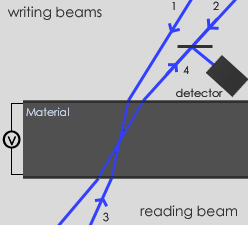Four-Wave Mixing


Four-wave mixing (FWM) geometry (on the right) is similar to that of the two-beam coupling. The difference is that in the FWM experiment, in addition to the writing beams 1 and 2, there is also a probe (reading) beam (beam 3) that is being partially diffracted from the grating created by the writing beams to create the fourth beam (beam 4). In the degenerate FWM geometry, which is common in photorefractive (PR) measurements, beam 3 has the same wavelength as the writing beams and is usually chosen to be counter-propagating to one of the writing beams as this results in a most efficient diffraction, as dictated by the Bragg condition,L. Solymar, D. Webb, A. Grunnet-Jepsen, "The physics and applications of photorefractive materials" (Clarendon Press: Oxford, 1996), H. Kogelnik, Bell Syst. Tech. J. 48, 2909 (1969) and allows for background-free detection of very weak diffraction signals (beam 4).
The diffracted beam intensity (i.e. that of beam 4) is typically measured as a function of time, applied electric field, writing beam intensities, etc. Then, the diffraction efficiency (η), defined as the ratio ηext=I4/I3 (external diffraction efficiency) or ηint= I4/(I4+I3') (internal diffraction efficiency, where I3' is the intensity of beam 3 transmitted through the sample) is determined. In probing the grating, it is important that beam 3 not affect the grating or interact with the writing beams. This can be assured by making the probe beam much weaker than the pump beams and/or by having the probe beam polarized orthogonal to the writing beams.
From the diffraction efficiency measured in geometry shown in figure on the right, in the approximation of thick (volume) grating, the modulation amplitude of the refractive index (Δn) is typically obtained by using the following expression:

where α is the absorption coefficient, and L is the effective interaction length, L=d/√(cosθ1 cosθ2). The vectors e1 and e2 are unit vectors along the electric field of the incident and diffracted beams, respectively, with e1•e2 = cos(θ2-θ1) for p-polarized readout (i.e. beam 3) and e1•e2=1 for s-polarized readout.
Note that at low applied electric fields E0, refractive index modulation Δn is small, and the diffraction efficiency η ~ (Δn)2 ~ Esc2.